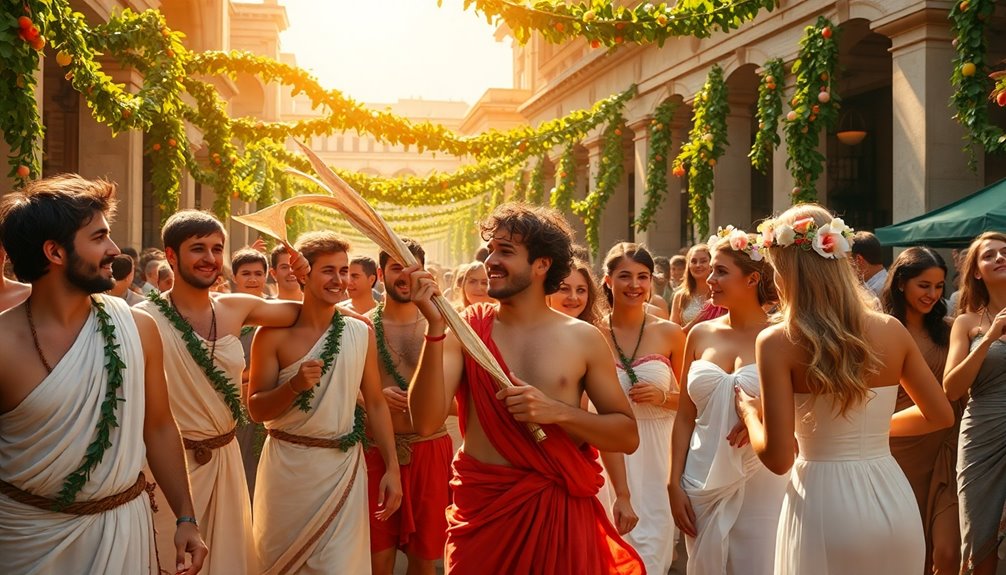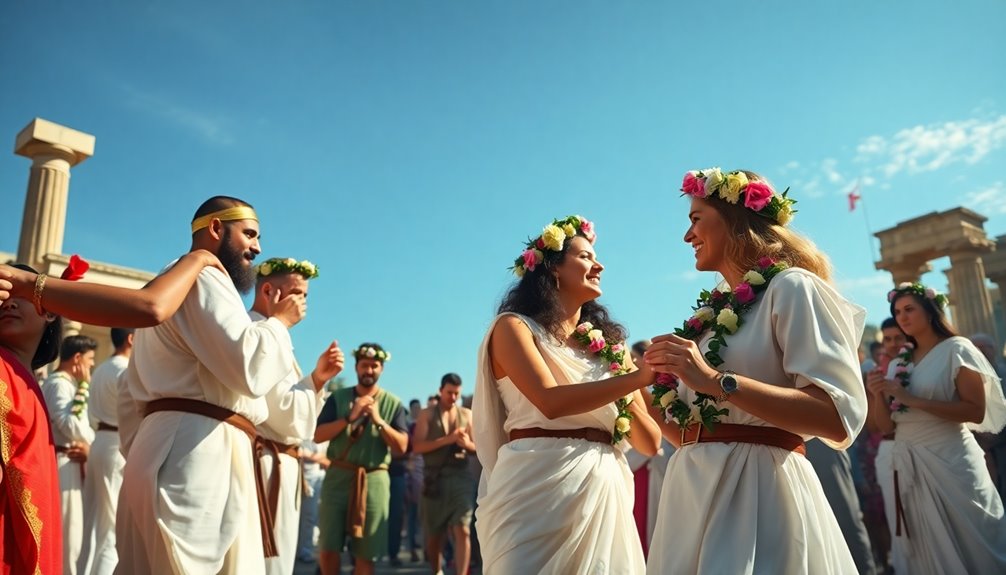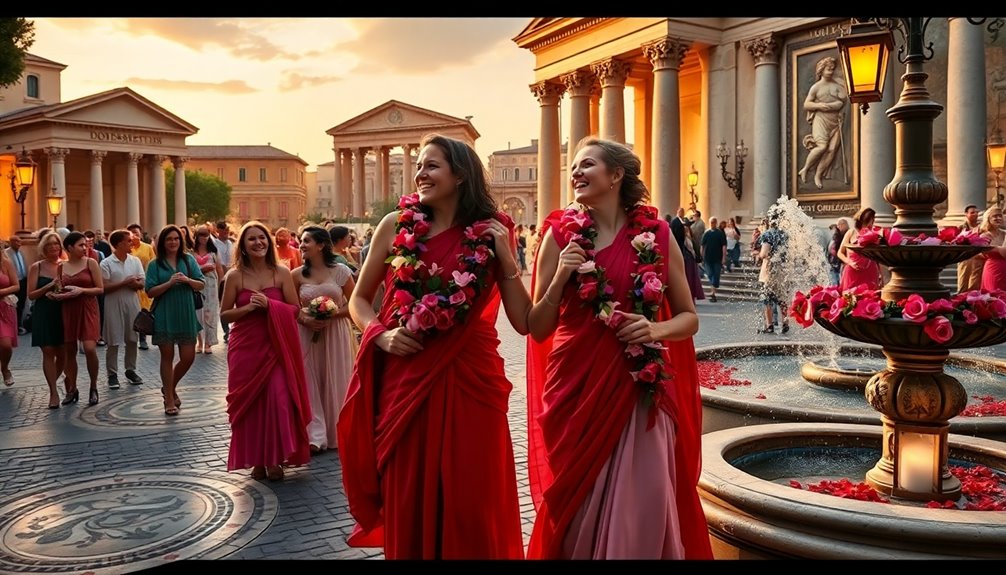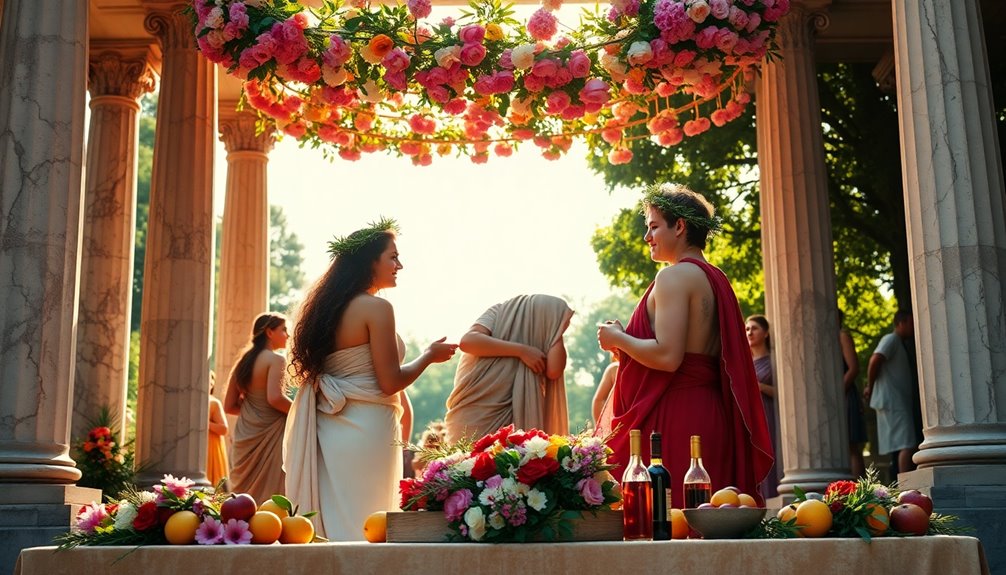Ancient Romans celebrated love through vibrant traditions like Lupercalia, held on February 15, focusing on purification and fertility. Priests performed animal sacrifices and engaged in rituals that included striking passersby with hides to promote fertility. This festival laid the groundwork for Valentine's Day, which evolved from the martyrdom of Saint Valentine. The blend of these celebrations reflects a rich cultural history. To uncover the fascinating details about love stories and rituals, just keep exploring.
Key Takeaways
- Lupercalia, an ancient Roman festival, celebrated purification and fertility, laying the groundwork for modern Valentine's Day traditions.
- Priests known as Luperci performed rituals, including animal sacrifices and fertility strikes, enhancing community prosperity.
- The festival involved name pairing rituals, symbolizing romantic connections and foreshadowing contemporary Valentine's practices.
- Saint Valentine of Rome's martyrdom on February 14 transformed the date into a celebration of love and commitment.
- Modern Valentine's Day reflects ancient traditions, with global variations and significant economic impact, emphasizing love and emotional connections.
The Origins of Lupercalia

As you explore the fascinating history of Lupercalia, you'll discover that this ancient Roman festival, originally called Februa, was celebrated on February 15 and focused on purification and fertility.
Dedicated to the gods Lupercus and Faunus, Lupercalia was deeply rooted in Rome's mythology, particularly the tale of Romulus and Remus.
Priests known as Luperci would perform animal sacrifices in the Lupercal cave on Palatine Hill, using the blood to anoint their foreheads.
One of the most intriguing customs was the drawing of names, where men and women were paired, symbolizing love and fertility.
Despite facing opposition from Christian leaders, Lupercalia's themes considerably influenced the later celebration of St. Valentine's Day, linking ancient traditions to modern expressions of love.
Rites and Rituals of the Festival

The Lupercalia festival, steeped in rich traditions and vibrant rituals, unfolds on February 15 each year, enchanting participants with its unique blend of purification and fertility rites.
During this lively event, you'll witness various significant rites, including:
- Sacrificial Offerings: Male goats and dogs are sacrificed at the Lupercal altar, with the blood used to anoint the foreheads of the Luperci priests, known as the "brothers of the wolf."
- Fertility Striking: The Luperci run around Palatine Hill, striking passersby with thongs made from animal hides, believed to enhance fertility and guarantee a bountiful harvest.
- Name Pairing Rituals: Names are drawn from a box, pairing men and women, a precursor to modern Valentine's Day traditions.
These rites embody the spirit of Lupercalia, celebrating love and renewal.
Locations of Significance

Ancient Rome was dotted with locations that held significant meaning during the Lupercalia festival. The Lupercal cave, nestled on Palatine Hill, served as the heart of the festival, where rites dedicated to fertility and purification took place.
Nearby, the sanctuary of Rumina emphasized nurturing and motherhood, integral to Roman culture. You'd find the wild fig-tree, Ficus Ruminalis, a symbol of Rome's founding through the myth of Romulus and Remus, underscoring the connection to wildlife and fertility.
The Forum bustled with energy as it hosted many communal rituals and celebrations, reinforcing the festival's spirit of togetherness.
Finally, the Caprificus tree linked to breastfeeding practices further intertwined nature with the rich tapestry of Lupercalia's customs.
The Role of Luperci Priesthood

Seven Luperci priests, known as the "brothers of the wolf," played an essential role in the Lupercalia festival, embodying the spirit of fertility and purification.
In ancient Rome, these priests performed rituals that were important for ensuring prosperity and good fortune within the community. You'd witness their unique practices, which included:
- Sacrificing male goats and dogs at the Lupercal altar.
- Anointing their foreheads with the blood from the sacrifices, symbolizing purification.
- Running around the Palatine Hill, striking people with thongs made from the sacrificed animals' hides to enhance fertility.
Through these acts, the Luperci priesthood connected religious traditions with Rome's founding myths, fostering a deep sense of community and celebration during Lupercalia.
Sacrificial Practices and Their Meaning

While participating in the Lupercalia festival, you'll witness sacrificial practices that hold profound significance for ancient Romans.
The Luperci priesthood performs sacrifices of male goats and a dog at the Lupercal altar, symbolizing purification and fertility. As they invoke divine favor, they anoint their foreheads with blood from the sacrificial knife, enhancing the community's fertility.
Salted mealcakes prepared by the Vestal Virgins are offered, connecting sustenance to the gods.
The festival's rituals include the Luperci running around Palatine Hill, striking individuals with thongs (februa), which promote fertility and ward off evil spirits.
These sacrifices and rituals are deeply rooted in Rome's foundation myths, reflecting the culture's reverence for deities tied to agriculture and the city's origins.
Historical Context and Cultural Significance

When you think about love celebrations in ancient times, it's fascinating to see how they evolved through rituals like Lupercalia.
This festival not only honored fertility but also brought communities together by pairing couples, reflecting a unique cultural significance.
As these traditions transformed into what we now recognize as Valentine's Day, they shaped the way we express love today.
Evolution of Love Celebrations
As love celebrations evolved over centuries, they reflected the cultural contexts and historical events shaping societies.
In ancient Rome, the festival of Lupercalia laid the groundwork for what would become the celebration of Valentine's Day. This shift included:
- The martyrdom of Saint Valentine, which occurred on February 14.
- Pope Gelasius I's decision to combine Lupercalia with Valentine's Day.
- Geoffrey Chaucer's 14th-century writings that linked February 14 with romantic love.
These changes highlight how the history of Valentine's Day transformed from ancient rites to a broader celebration. Additionally, the significance of emotional readiness in relationships has been a crucial theme throughout history, emphasizing the importance of mutual understanding and support in love.
As courtly love flourished, love celebrations grew in significance, evolving into diverse customs worldwide, reflecting a universal appreciation for love and affection that endures today.
Rituals of Fertility and Pairing
Rituals of fertility and pairing in ancient cultures reveal deep-rooted beliefs about love, sexuality, and community.
One of the most significant festivals was Lupercalia, celebrated from February 13th to 15th in ancient Rome. During this time, young men participated in rituals aimed at enhancing fertility and pairing couples. They drew names of women from a box, fostering temporary romantic connections.
The Luperci, priests dedicated to the god Faunus, conducted animal sacrifices, using the sacrificial thongs to strike women, a gesture believed to promote fertility and ease childbirth.
Central to these rites was the wild fig tree, symbolizing nature's role in agriculture and fertility.
These ancient customs eventually laid the groundwork for modern celebrations of love, including Valentine's Day.
The Evolution of Valentine's Day

You might be surprised to learn that Valentine's Day has roots in the ancient Roman festival of Lupercalia, where fertility rituals played a central role.
As the martyrdom of Saint Valentine became intertwined with this celebration, the day shifted towards honoring love.
Over the centuries, this transformation paved the way for the Valentine's Day we recognize today.
Lupercalia's Fertility Rituals
Every February 15, ancient Romans celebrated Lupercalia, a festival steeped in rituals aimed at promoting fertility and purification.
This lively event was dedicated to the god Faunus and involved the Luperci priests performing various rites.
You'd witness several fascinating activities, including:
- Sacrificing goats and a dog to honor the gods.
- Drawing names of women from a box to create temporary pairs, believed to boost fertility.
- Running through the streets, Luperci would strike people with thongs called februa, encouraging fertility.
These Lupercalia rituals, linked to the legendary figures Romulus and Remus, were held in the sacred cave of Lupercal, solidifying their importance in Roman culture.
Over time, the festival evolved, paving the way for modern Valentine's Day.
Saint Valentine's Legacy
As the echoes of Lupercalia faded, the emergence of Saint Valentine's Day began to take shape, rooted in the martyrdom of a devoted priest. Valentine of Rome secretly married Christian couples during Emperor Claudius II's reign, ultimately leading to his execution around 269 AD.
By the High Middle Ages, his connection to romantic love solidified, especially through Geoffrey Chaucer's works that linked February 14 with courtly love. In the 5th century, Pope Gelasius I declared this day as St. Valentine's Day, replacing pagan traditions.
The first known love letter, sent by Charles, duke of Orleans in 1415, marked the start of exchanging love letters. Over time, this day evolved into a commercial holiday, celebrating affection through cards and gifts.
Love Stories: Sabino and Serapia

In the charming piazza of Terni, a Roman Centurion named Sabino found himself irresistibly drawn to the beauty of Serapia, igniting a love story that would defy the odds.
Their relationship faced significant obstacles due to their different faiths; Serapia's Christian parents opposed her union with a pagan.
However, the couple's love caught the attention of Bishop Valentino, who played a vital role in their story.
- Their secret marriage defied societal norms.
- Serapia fell seriously ill before their planned wedding.
- Valentino administered last rites and united them in a final act of love.
The enduring tale of Sabino and Serapia symbolizes love's power, forever linked to the legacy of Saint Valentine and the origins of Valentine's Day.
Modern Interpretations and Celebrations

What makes modern interpretations of Valentine's Day so enchanting? You see echoes of the ancient Roman festival of Lupercalia, where love and fertility were celebrated through playful pairing.
Today, you exchange love letters and cards, a tradition that blossomed in the 18th century from Lupercalia's name-drawing practices. Valentine's Day has transformed into a commercial powerhouse, with Americans spending around $21 billion annually on gifts, cards, and flowers.
While it originally honored religious figures, contemporary festivities focus on romantic love. You might enjoy an elaborate dinner or surprise gifts, making the day feel special. Clear communication during this time can enhance the emotional connection between partners.
Worldwide, variations like Japan's dual celebrations highlight the holiday's significance, ensuring love is celebrated in diverse, meaningful ways.
Frequently Asked Questions
What Was Love Like in Ancient Rome?
In ancient Rome, love wasn't just about romance; it often revolved around societal expectations. You'd see marriages arranged for political gain rather than affection.
While passionate love existed, most relationships prioritized duty over desire. Public expressions of love were common, especially during festivals that aimed to pair couples.
You might find poets like Ovid exploring themes of seduction and longing, yet the reality often leaned more towards obligation than true emotional connection.
How Did Ancient Rome Celebrate Valentine's Day?
Ever wondered how love was celebrated in ancient Rome? They held a festival called Lupercalia from February 13 to 15.
During this lively event, men drew names of women to pair up for the festivities, fostering romantic connections.
Priests called the Luperci performed animal sacrifices and ran through the streets, striking people with thongs to promote fertility.
This vibrant celebration eventually evolved into what we now recognize as Valentine's Day.
What Happens on Lupercalia?
On Lupercalia, you'd witness lively rituals starting with the sacrifice of goats and a dog by the Luperci priests.
Afterward, they'd anoint their foreheads with the blood and run around the Palatine Hill, playfully striking people with thongs made from goat hides to promote fertility.
You might even draw names from a box, pairing with someone for fun.
The atmosphere is festive, celebrating life and love in a unique, spirited way.
What Day Do We Honor the Roman Goddess of Love?
You honor the Roman goddess of love, Venus, on April 1st during the festival called Veneralia.
This day's all about celebrating love, beauty, and fertility. Couples come together to make offerings and prayers, seeking Venus's blessings for their relationships.
It's a vibrant occasion filled with rituals that express devotion and hope for romantic fulfillment.
Conclusion
In the grand tapestry of love, Lupercalia stands as a dazzling gem, outshining the stars themselves! You can't help but feel the vibrant energy of ancient Romans celebrating their passions, igniting flames of romance that still flicker today. As you revel in modern Valentine's Day festivities, remember these age-old traditions that weave together heartbeats and whispers of affection. So, let love reign supreme, not just today, but every day, because who wouldn't want to bask in such glorious devotion?









